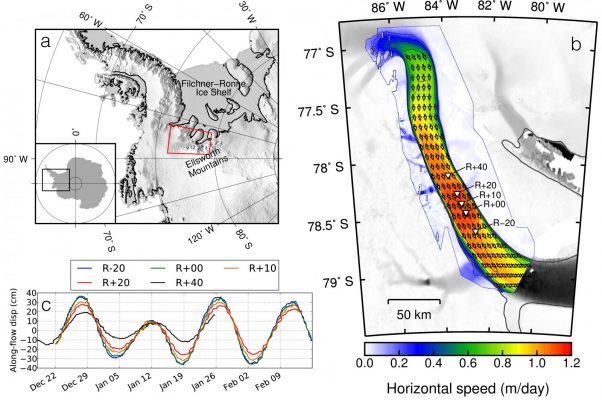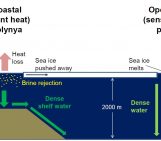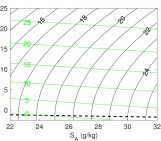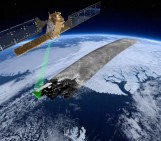
Ice streams discharge approximately 90% of the Antarctic ice onto ice shelves , and ultimately into the sea into the sea (Bamber et al., 2000; Rignot et al., 2011). Whilst flow-speed changes on annual timescales are frequently discussed, we consider here what happens on much shorter timescales!
Previous studies have shown that ice streams can respond to ocean tides at distances up to 100km inland (e.g. Gudmundsson, 2006 ; Murray et al., 2007; Rosier et al, 2014); new high-resolution remotely sensed data provide a synpoptic-scale view of the response of ice flow in Rutford Ice Stream (West Antarctica), to ocean tidal motion.
These are the first results to capture the flow of an entire ice stream and its proximal ice shelf in all three spatial dimensions and in time.
The ocean controls the Antarctic ice sheet
The ice-ocean interface is very important as nearly all ice-mass loss occurs directly into the ocean in Antarctica (Shepherd et al., 2012). Many areas terminate on ice shelves (the floating ice that connects with the land ice), which are fed by the flow of ice from the ice sheet. Any changes to the floating ice shelf alter the forces acting on the grounded ice upstream, therefore directly affecting the ice sheet evolution (e.g. Gudmundsson, 2013; Scambos et al, 2004).
Because ocean tides are well-understood, we can use the response of grounded ice streams to ocean tidal uplift over the ice shelf to better understand how ice sheets respond to ocean-induced changes.
An ice stream and ice shelf respond to forcing by ocean tides
Floating ice shelves are directly affected by tides, as their vertical displacement will be altered. These tidal variations are on short timescales (hourly to daily) compared to the timescales generally associated with ice flow (yearly). The question therefore is, how much can the tides affect horizontal flow speeds, and how far inland of the ice shelf are these effects felt?
The movie below, by Brent Minchew et al, shows the significant response of Rutford Ice Stream and its ice shelf to forcing by the tides. Using high-resolution synthetic aperture radar data they are able to infer the significant spatio-temporal response of Rutford Ice Stream in West Antarctica to ocean tidal forcing. The flow is modulated by the ocean tides to nearly 100km inland of the grounding line. These flow variations propagate inland at a mean rate of approximately 30 km/day and are sensitive to local ice thickness and the mechanical properties of the ice-bed interface. Variations in horizontal ice flow originate over the ice shelf, indicating a change in (restraining force) over tidal timescales, which is largely attributable to the ice shelf lifting off of shallow bathymetry near the margins. Upstream propagation of ice flow variations provides insights into the sensitivity of grounded ice streams to variations in ice shelf buttressing.
Horizontal ice flow on Rutford Ice Stream inferred from 9 months of continuous synthetic aperture radar observations. (a) Total horizontal flow. Colormap indicates horizontal speed and arrows give flow direction. (b) Detrended horizontal flow variability over a 14.77-day period. Colormap indicates the along-flow component (negative values oppose flow) while arrows indicate magnitude and direction of tidal variability. Contour lines give secular horizontal speed in 20 cm/day increments. (c) Modelled vertical tidal displacement over the ice shelf. (Credit : Brent Minchew)
Reference
B. M. Minchew, M. Simons, B. V. Riel, and P. Milillo. Tidally induced variations in vertical and horizontal motion on Rutford Ice Stream, West Antarctica, inferred from remotely sensed observations. submitted to JGR, 2016
(Edited by Sophie Berger and Emma Smith)
Teresa Kyrke-Smith is a postdoctoral researcher at the British Antarctic Survey, on the iSTAR grant. She works on using inversion methods to learn about the nature of basal control on the flow of Pine Island Glacier in West Antarctica. She completed her PhD two years ago in Oxford; her thesis focused on the feedbacks between ice streams and subglacial hydrology.
Brent Minchew is an National Science Foundation Postdoctoral Fellow also now based at the British Antarctic Survey.






Pingback: Cryospheric Sciences | Icequakes, the little brothers of earthquakes, what do they tell us about ice flow?